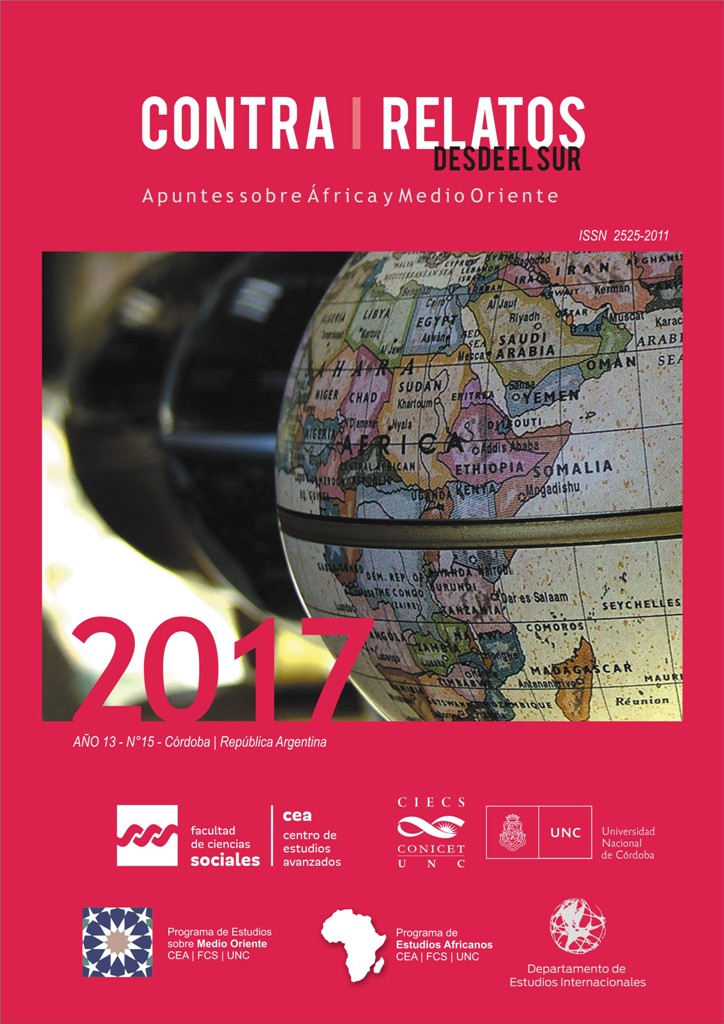MUJERES EN LAS FUERZAS ARMADAS REGULARES E IRREGULARES DE LAS PROVINCIAS DEL ESTE DE LA REPÚBLICA DEMOCRÁTICA DEL CONGO: UNA PROBLEMATIZACIÓN DEL GÉNERO DE LA GUERRA
Abstract
Empero los estudios sobre la participación de la mujer en las fuerzas armadas regulares e irregulares que operaron en las provincias del este de la República Democrática del Congo sean escasos, la cantidad que, de hecho, actuaron dentro de sendos grupos nos obliga a visitar y examinar su intervención. Luego, ello resulta en la necesidad de problematizar el género de la guerra, la cual ya no es una cuestión masculina, sino que la mujer se encuentra constantemente involucrada y es perpetradora de actos de violencia a pesar de su invisibilización a través de narrativas que pretenden demostrar ese comportamiento como excepcional.
References
Åhäll, L. (2012). The Writing of Heroines: Motherhood and Female Agency in Political Violence. Security Dialogue, 43(4), 287–303.
Alison, M. (2004). Women as Agents of Political Violence: Gendering Security. Security Dialogue, 35(4), 447–463.
Brown, S. (2013). Female Perpetrators of the Rwandan Genocide. International Feminist Journal of Politics, 16(3), 448–469.
Cardi, C. y Pruvost, G. (2011). The Violence of Women: Supressions and Narratives. Champ Pénal/Penal Field, VIII. Disponible en: https://champpenal.revues.org/8367 (consultado el 2 de abril de 2017).
Cockburn, C. (2010). Gender Relations as Casual in Militarization and War. International Feminist Journal of Politics, 12(2), 139–157.
Coulter, C., Persson, M. y Utas, M. (2008). Young Female Fighters in African Wars. Conflict and its Consequences. Uppsala: Nordiska Afrikainstitutet.
Durham, H. y O’Byrne, K. (2010). El Dialogo de la Diferencia: el Derecho Internacional Humanitario y las Perspectivas de Género. International Review of the Red Cross, 92(877), 35–58.
El–Bushra, J. (2000). Transforming Conflict: Some Thoughts on a Gendered Understand-ing of Conflict Processes. En Jacobs, S., Jacobson, R. y Marchbank, J. (eds.) States of Conflict. Gender, Violence and Resistance. Londres y Nueva York: Zed Books, 66–86.
Elshtain, J. (1995). Women and War. Chicago y Londres: The University of Chicago Press.
Enloe, C. (1983). Does Khaki Become you?: The Militarization of Women’s Lives. Boston: South End Press.
Eriksson Baaz, M. y Stern, M. (2011). Whores, Men and other Misfits: Undoing ‘Feminization’ in the Armed Forces of the DRC. African Affairs, 110(441), 563–585.
Eriksson Baaz, M. y Stern, M. (2013). Fearless Fighters and Submissive Wives: Negotiating Identity among Women Soldiers in the Congo (DRC). Armed Forces and Society, 39(4), 711–739.
Gentry, C. (2012). Thinking about Women, Violence, and Agency. International Feminist Journal of Politics, 14(1), 79–82.
Hogg, N. (2010). La Participación de las Mujeres en el Genocidio de Ruanda: ¿Madres o Monstruos? International Review of the Red Cross, 92(877), 59–95.
Le Bodic, C. (2011). Peut–on Penser la Violence des Femmes sans Ontoligiser la Diffé-rence des Sexes? Champ Pénal / Penal Field, VIII, 1–13. Disponible en: https://champpenal.revues.org/8092 (consultado el 2 de abril de 2017).
Leatherman, J. (2011). Sexual Violence and Armed Conflict. Cambridge: Polity.
Mazurana, D., McKay, S., Carlson, K. y Kasper, J. (2002). Girls in Fighting Forces and Groups: Their Recruitment, Participation, Demobilization, and Reintegration. Peace and Conflict: Journal of Peace Psychology, 8(2), 97–123.
Ness, C. (2007). The Rise in Female Violence. Dæedalus, edición de invierno, 84–93.
Steans, J. (2013). Gender and International Relations. Theory, Practice and Policy. Cambridge y Malden, Ma.: Polity. 3ra ed.
Stearns, J. Verweijen, J. y Eriksson Baaz, M. (2013). The National Army and Armed Groups in the Eastern Congo. Untangling the Gordian Knot of Insecurity. Rift Valley Institute, the Usalama Project. Disponible en: http://riftvalley.net/publication/national–army–and–armed–groups–eastern–congo#.WOFC5m_hCUs (consultado el 2 de abril de 2017).
Tessler, M. y Warriner, I. (1997). Gender, Feminism, and Attitudes toward International Conflict: Exploring Relationships with Survey Data from Middle East. World Politics, 49(2), 250–281.
Verhey, B. (2004). Reaching the Girls. Study on Girls Associated with Armed Forces and Groupes in the Democratic Republic of Congo. Save the Children UK and the NGO Group: CARE, IFESH and IRC. http://resourcecentre.savethechildren.se/library/reaching–girls–study–girls–associated–armed–forces–and–groups–democratic–republic–congo (consultado el 2 de abril de 2017).
Downloads
Published
Issue
Section
License
Copyright (c) 2017 Irina Lamadrid

This work is licensed under a Creative Commons Attribution-NonCommercial-ShareAlike 4.0 International License.
Usted es libre de:
- Compartir — copiar y redistribuir el material en cualquier medio o formato
- Adaptar — remezclar, transformar y construir a partir del material
Bajo los siguientes términos:
-
Atribución — Usted debe dar crédito de manera adecuada, brindar un enlace a la licencia, e indicar si se han realizado cambios. Puede hacerlo en cualquier forma razonable, pero no de forma tal que sugiera que usted o su uso tienen el apoyo de la licenciante.
-
NoComercial — Usted no puede hacer uso del material con propósitos comerciales.
-
CompartirIgual — Si remezcla, transforma o crea a partir del material, debe distribuir su contribución bajo la lamisma licencia del original.


